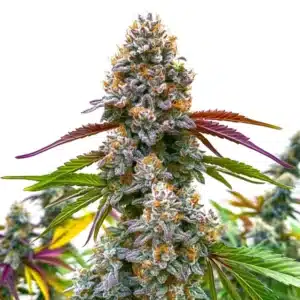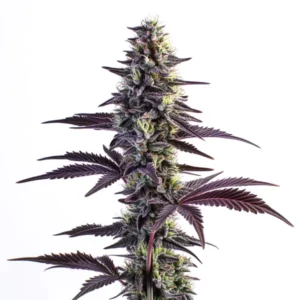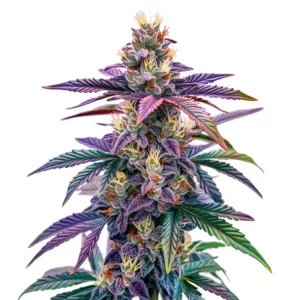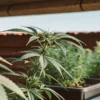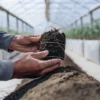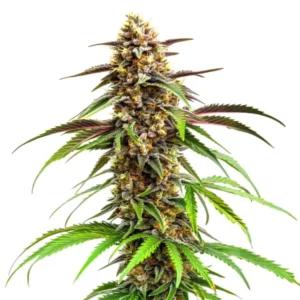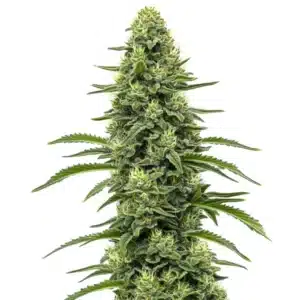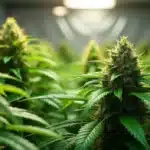
How to Optimize Red:Far-Red Ratio for Cannabis
Getting the best out of your cannabis plants often boils down to light—specifically, the red:far-red ratio. This balance can significantly affect growth phases, influencing both size and yield. The red:far-red light spectrum is key for maximizing the flowering stage, ensuring lush and bountiful harvests. Growers looking to improve results should learn How to Optimize Red:Far-Red Ratio for Cannabis, as proper adjustment of this spectrum directly impacts bud density, stretch control, and overall yield.
For those new to growing or seasoned pros, the ideal red:far-red ratio for cannabis growth can sometimes seem elusive. However, knowing the basics of how to optimize red:far-red ratio for cannabis can unlock the door to healthier plants. It’s all about the balance and how it interacts with your specific cannabis strain.
Recommended Strains
Critical Daddy Purple
|
|
THC | 19% (Medium) |
|
|
Type | Feminized |
|
|
Yield | High |
|
|
Phenotype | 50% Indica / 50% Sativa |
GG4
|
|
THC | 27% (High) |
|
|
Type | Feminized |
|
|
Yield | High |
|
|
Phenotype | 40% Indica / 60% Sativa |
When adjusting red:far-red ratio in cannabis cultivation, consider the strain you’re working with. For instance, Blimburn Seeds offers strains like Gorilla G4, which responds well to specific light conditions. Tailoring your approach can make a big difference in the overall health and yield of your plants.
Importance of the Red:Far-Red Ratio
The red:far-red ratio affects how your cannabis plants perceive the light environment. A higher ratio of red light promotes vegetative growth, leading to robust plants. On the other hand, far-red light encourages flowering. The best red:far-red ratio for cannabis flowering is often a fine balance.
Think of it like tuning a radio. Too much red light and your plants might grow too leafy, delaying flowering. Too much far-red and they might stretch excessively. Each strain is different, so experimenting with this ratio can help find the sweet spot for your specific setup.
Knowing the red:far-red balance is crucial for both novice and experienced growers. The effects of red:far-red balance on cannabis yield can be profound, influencing not just the quantity but also the quality of the harvest. Recognizing how these light spectrums affect various strains will guide you in making informed adjustments to enhance plant health.
Moreover, the importance of this ratio extends beyond mere growth. It can also impact the plant’s resistance to stress and pests. By optimizing red:far-red light spectrum for cannabis, growers can enhance resilience, resulting in stronger plants that are better equipped to handle environmental fluctuations and produce superior yields.
Promos & Deals
Adjusting Red:Far-Red Ratio in Cannabis Cultivation
To adjust the red:far-red ratio, growers can use LED lights that provide control over light spectrums. Start by setting a baseline with a full-spectrum LED and then adjust based on plant response. Monitor your plants’ growth patterns and adjust accordingly.
Take the Critical Daddy Purple from Blimburn Seeds, for example. This strain flourishes with a slightly higher far-red proportion during flowering. By optimizing red:far-red light spectrum for cannabis, you can encourage denser buds and improved yields.
Adjusting the red:far-red ratio in cannabis cultivation requires careful observation and tweaking. Begin by establishing a standard with your lighting setup, then make incremental changes. Documenting each adjustment allows you to track which ratios yield the best results for your specific strains, leading to more effective cultivation practices.
Furthermore, utilizing technology such as light sensors can provide real-time feedback on how your plants are responding. This can help fine-tune the lighting environment, ensuring that the ideal red:far-red ratio for cannabis growth is consistently maintained throughout the cultivation process.

Practical Ways to Optimize the Red:Far-Red Ratio
Using LEDs with adjustable spectrums is a practical way to optimize the red:far-red ratio. These lights allow you to tweak the balance as your plants progress through their growth stages. Consider investing in quality LEDs that offer this flexibility.
Another practical tip is to observe your plants closely. They will tell you what they need if you pay attention. If leaves are overly green and growth seems slow, increase the red light. If plants are tall and spindly, boost the far-red to trigger flowering.
Adopting a hands-on approach is crucial. Regularly inspecting the physical characteristics of your plants can provide insights into their light needs. Implementing slight changes and observing the outcomes will guide you toward finding the best red:far-red ratio for cannabis flowering, ultimately improving your yields.
Engaging in peer forums or grower communities can also provide valuable insights and tips. Sharing experiences and learning from others who have mastered how to optimize red:far-red ratio for cannabis can shorten the learning curve and enhance your cultivation skills.
Effects of Red:Far-Red Balance on Cannabis Yield
The effects of red:far-red balance on cannabis yield are profound. A well-optimized spectrum can lead to increased bud production and overall plant health. This balance affects not just the number of flowers, but their size and potency as well.
By adjusting the red:far-red ratio, you can fine-tune your grow operation. This adjustment can mean the difference between an average harvest and one that exceeds expectations. It’s all about knowing how different spectrums interact with your plants.
Achieving an ideal red:far-red ratio for cannabis growth requires patience and precision. The right balance not only maximizes yield but also enhances the plant’s cannabinoid profile, leading to a more potent and aromatic product. This optimization is key to tapping into the full potential of your cannabis plants.
Besides to yield and potency, a balanced red:far-red spectrum can improve the overall aesthetic quality of the plants. Vibrant colors and healthy foliage are indicators of well-managed light conditions, contributing to a visually appealing and commercially viable crop.
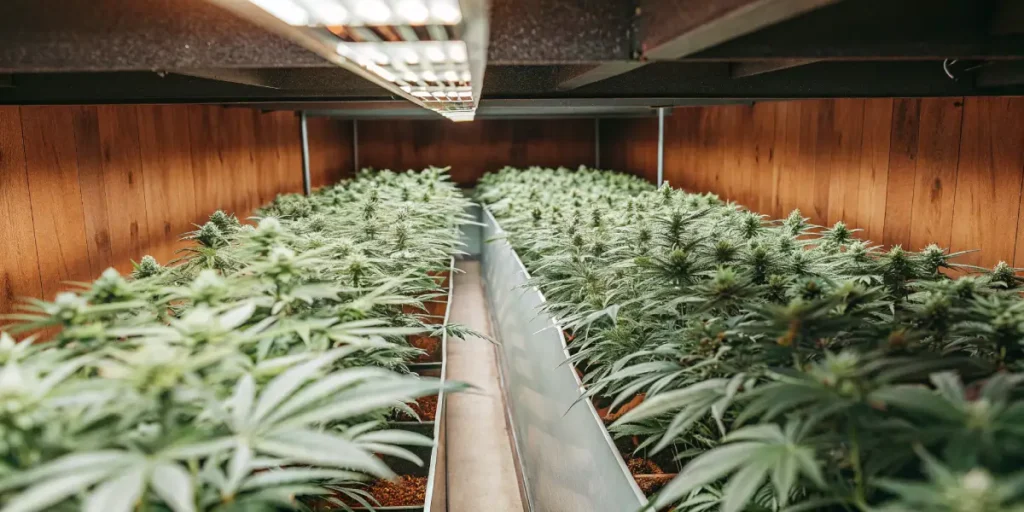
FAQs
What is the ideal red:far-red ratio for cannabis growth?
The ideal red:far-red ratio for cannabis growth varies depending on the strain and growth phase. During vegetative growth, a higher red light ratio is beneficial. This promotes more robust plant structures. In contrast, the flowering phase benefits from increased far-red light, which encourages bud development.
Monitoring your plants and adjusting the light spectrum accordingly is key. Strains like Gorilla G4 respond well to these adjustments, allowing you to maximize growth potential. It’s important to experiment and document changes to find what works best for your particular setup.
Knowing the specific needs of your cannabis strains is crucial to determining the ideal red:far-red ratio. Some strains may require slight deviations from standard light ratios to thrive. Keeping detailed records of light adjustments and plant responses can help refine your approach over time.
Consistency and patience are vital. The ideal ratio may not be immediately apparent, but through diligent observation and adjustment, growers can discover the optimal conditions for their particular environment, leading to healthier and more productive plants.
How does adjusting the red:far-red ratio impact cannabis flowering?
Adjusting the red:far-red ratio can significantly impact cannabis flowering. A higher proportion of far-red light signals the plant to enter the flowering stage earlier. This can lead to earlier bud sites and potentially a more abundant harvest.
Strains like Critical Daddy Purple react well to these changes, showing improved flowering times and denser buds. Fine-tuning this ratio is crucial for those looking to enhance their flowering phase and achieve premium quality yields.
The timing of adjustments plays a crucial role in optimizing flowering. Introducing far-red light at the appropriate growth stage can synchronize flowering across your crop, resulting in a more uniform and manageable harvest. This strategy is essential for commercial growers aiming to streamline their operations.
Furthermore, knowing plant physiology and how it responds to light changes can inform more strategic adjustments. By learning how to optimize red:far-red ratio for cannabis, growers can better predict flowering behaviors and adapt their techniques to suit different strains and growing conditions.
Are there specific strains that benefit more from red:far-red optimization?
Yes, specific strains do benefit more from red:far-red optimization. For example, Zombie Death Fuck can show significant improvements in growth and yield with well-adjusted light spectrums. Each strain has its unique needs, and tailoring the light environment can bring out the best in each one.
Using strains from Blimburn Seeds, which are bred for specific traits, allows growers to experiment and find the optimal light conditions. By knowing the nuances of each strain, you can make informed decisions about light adjustments.
Exploring the genetic background of your cannabis strains can offer insights into their light preferences. This knowledge can guide light spectrum adjustments, ensuring that the effects of red:far-red balance on cannabis yield are maximized. Hiring experts or consulting resources can also provide valuable strain-specific guidance.
Additionally, documenting your findings and sharing them with the grower community can contribute to collective knowledge. This exchange can help identify which strains benefit most from specific light optimizations, aiding both personal and communal cultivation endeavors.
Can optimizing the red:far-red ratio improve cannabis yield?
Optimizing the red:far-red ratio can indeed improve cannabis yield. By achieving the right balance of light spectrums, plants can grow more vigorously and produce higher-quality flowers. This optimization is a critical component for any grower looking to maximize output.
Experiment with different ratios using adjustable LEDs and observe how your plants respond. With strains like Critical Daddy Purple from Blimburn Seeds, even small adjustments can lead to noticeable improvements in both yield and quality.
Investing in research and development to better understand light interactions can further enhance the benefits of optimizing red:far-red light spectrum for cannabis. By continually refining techniques, growers can consistently achieve superior harvests, contributing to both personal satisfaction and market success.
Moreover, utilizing data analytics and plant monitoring technologies can streamline the optimization process. These tools can provide actionable insights, allowing growers to implement precise adjustments that enhance yield, potency, and plant health in a data-driven manner.
What tools are helpful for adjusting the red:far-red ratio?
LED grow lights with adjustable spectrums are invaluable for adjusting the red:far-red ratio. These lights allow for precise control over the light environment, enabling you to cater to the specific needs of your plants during different growth stages.
Invest in quality lighting solutions that offer full-spectrum capabilities. Monitor your plants’ responses and adjust as needed. With the right tools and approach, optimizing the red:far-red ratio becomes a practical and rewarding aspect of cannabis cultivation.
Beyond lighting, integrating environmental sensors and automation systems can enhance control over the cultivation environment. These tools provide real-time feedback and allow for automated adjustments, ensuring that the ideal red:far-red ratio for cannabis growth is maintained with minimal manual intervention.
Additionally, leveraging software platforms that integrate with grow systems can facilitate detailed tracking and analysis. These platforms can offer insights into the effects of red:far-red balance on cannabis yield, enabling more informed and effective cultivation strategies.


